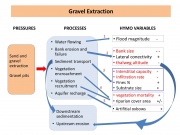Sand and gravel extraction
Contents
Sand and gravel extraction
04. Morphological alterations
General description
Sand and gravel are crucial resources for economic development activities, such as road building and concrete production. As a result, sand and gravel mining is a major economic activity that is often carried out within river channels and floodplains. Because annual extraction rates often greatly exceed fluvial transport, these activities lead to river bed incision, disconnection of the river from its floodplain, depression of water table levels in the alluvial aquifer, and sometimes a complete change in channel style, for example from braiding to single thread planforms.
Effect/Impact on (including literature citations)
The extraction of sand and gravel from river beds, banks and floodplains is driven by human needs for raw materials for concrete, glass and paint making, and construction works. Direct extraction of alluvial material from river channels causes far greater impacts than floodplain extraction. According to Rinaldi et al. (2005), the effects of bed sediment mining are more severe: where material is extracted at a rate greatly exceeding the replenishment rate where extraction is from single-thread rivers, that are generally associated with relatively low rates of catchment sediment supply; from channelized reaches, where sediment supply is also limited; from channels where there is only a thin cover of alluvium over bedrock; and at locations where mining coincides with other human activities that reduce upstream sediment delivery (especially large dams). Bed sediment mining alters flood magnitude and frequency (Rinaldi et al., 2005) and local flow hydraulics, inducing supplementary erosion on both sides of the extraction pit (Rivier and Seguier 1985); reduces sediment availability, changing sediment dynamics and inducing bed incision (Kondolf, 1997) and armouring (Kelly et al., 2005). These changes in sediment dynamics can lead to either bed siltation or armouring downstream (Rinaldi et al. 2005), local destabilization of the substratum (Rivier and Seguier 1985), and upstream erosion (López 2004, Rinaldi et al. 2005). In addition, bed incision lowers alluvial water tables and affects vegetation dynamics (Kondolf, 1994, 1997). These effects extend well beyond the sites affected by extraction, including reduction in flood levels, changes in longitudinal and transverse channel profiles, and alterations in stream bed, bank and riparian community characteristics. Gravel extraction from the river bed can also lead to bank erosion and failure. Altered bank dynamics change the bank profile and stream course, potentially inducing a loss of vegetation on stream banks and reduced delivery and retention of large wood. The nature of channel adjustments depends on local factors, most notably the local sediment budget and the method of gravel extraction (Wishart et al., 2008). However, Brown et al. (1998) reported that stream morphology is changed after gravel mining mainly by a lack of gravel bedload to replace the mined sediment, rather than by how the bed material removed. Examples of the effects of morphological degradation caused by gravel mining are numerous. Erskine et al. (1985) predicted imminent channel degradation as a result of rates of extraction from temporary sediment stores within the Hunter River, Australia, upstream of Denman, greatly exceeding contemporary transport rates. Similarly, gravel extraction from Stony Creek, California, USA that greatly exceeds delivery rates has induced channel incision of over 5 m of channel bed incision, necessitating bridge repairs costing US$1.4 million (Kondolf and Swanson 1993). In addition to channel incision and degradation, gravel extraction can lead to changes in the patterns of water exchange between surface and subsurface (Mori et al. 2011) and indirect effects that include a reduction in shading and bank cover; an increase in stream temperature that favours the rapid growth of algae and weeds that cover the water surface; release and redistribution of adsorbed pollutants; and changes in the turbidity of the water column (Rivier and Seguier 1985, Tamunobereton-ari and Omubo-Pepple 2011). In downstream locations, a decline in the level of the alluvial water table can result in salt water intrusion, as was observed by Mas-Pla et al. (1999) within the aquifer-river system close to the coast of the Baix Fluviá area (NE Spain). While in-channel mining commonly causes bed incision and severe upstream and downstream effects, floodplain gravel pits produced by gravel extraction have more local effects and have the potential to become wildlife habitat. However, they may be captured by migration of the active river channel (Kondolf 1997) and eventually contribute to the morphological and ecological changes observed in the main channel.
Case studies where this pressure is present
- Millingerwaard
- Eggenstein-Leopoldshafen_-_Living_Rhine_floodplain_near_Karlsruhe_(LIFE04_NAT/DE/000025
- Conservation_of_Atlantic_Salmon_in_Scotland_(LIFE_04/NAT/GB/000250)
- Klebach_-_Side_channel
- Bouxweerd
- Blenheim_Palace_Project
- River_Wensum_Rehabilitation_Project
- Asseltse_Plassen_-_Bank_erosion
- Vreugderijkerwaard_-_Side_channel
- Rijkelse_Beemden_-_River_bed_widening
- Zújar.
- Buiten_Ooij_-_Sluice_operation_
- Improvement_of_aquatic_habitat_of_Segre_River__at_Alòs_de_Balaguer
- Karlsruhe_–_Living_Rhine_floodplain_near_Karlsruhe_(LIFE04_NAT/DE/000025)
- IJssel
- River_Rhine_-_IJsseluiterwaarden_Olst
- Rhine_-_Meinerswijk
- Rhine_-_Nebenrinne_Bislich-Vahnum_(LIFE08_NAT/D/000007)
- Rhine_-_Emmericher_Ward_(LIFE10_NAT/DE/000010)
- Lower_Traun
- Drava_-_Kleblach
- Enns_-_Aich
Possible restoration, rehabilitation and mitigation measures
- Improve continuity of sediment transport
- Add sediments
- Reduce impact of dredging
- Reduce undesired sediment input
- Reduce erosion
